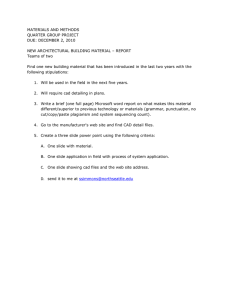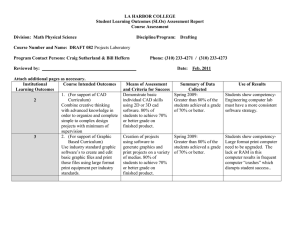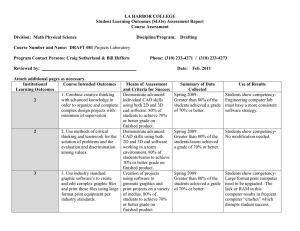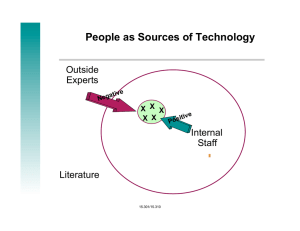Graphic Communication Standards and conventions
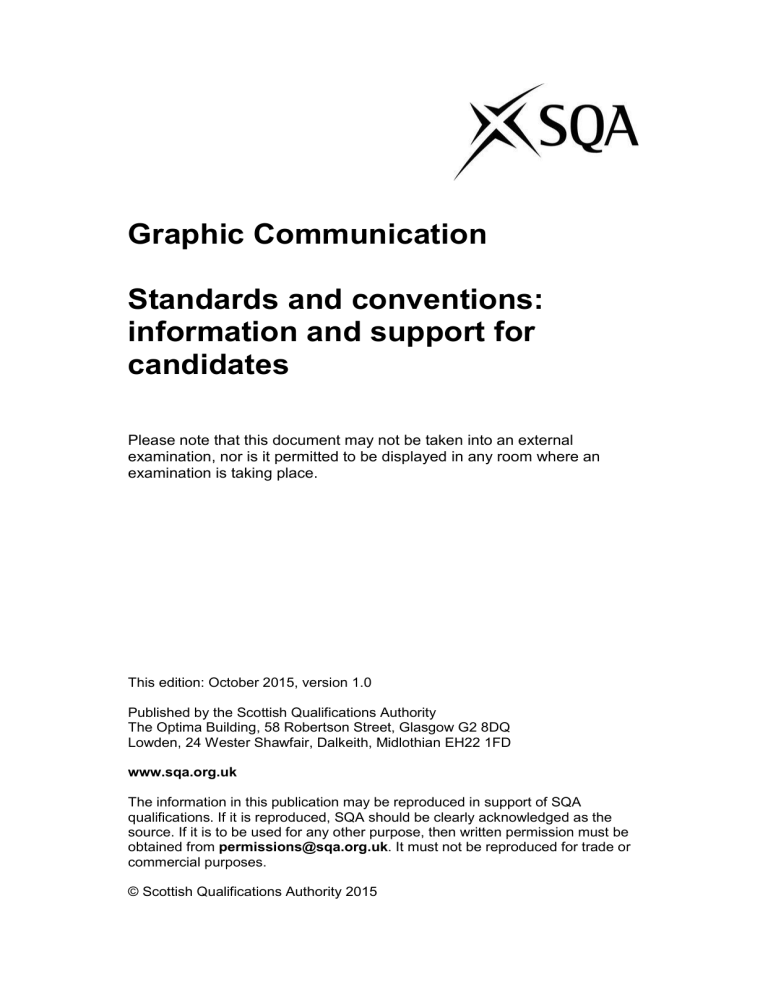
Graphic Communication
Standards and conventions: information and support for candidates
Please note that this document may not be taken into an external examination, nor is it permitted to be displayed in any room where an examination is taking place.
This edition: October 2015, version 1.0
Published by the Scottish Qualifications Authority
The Optima Building, 58 Robertson Street, Glasgow G2 8DQ
Lowden, 24 Wester Shawfair, Dalkeith, Midlothian EH22 1FD www.sqa.org.uk
The information in this publication may be reproduced in support of SQA qualifications. If it is reproduced, SQA should be clearly acknowledged as the source. If it is to be used for any other purpose, then written permission must be obtained from permissions@sqa.org.uk
. It must not be reproduced for trade or commercial purposes.
© Scottish Qualifications Authority 2015
Introduction
This support document provides information on the expected use of Standards and Conventions for all SQA Graphic Communication Courses. It is not intended to be an exhaustive list of those used in the graphic industry, nor does it cover every single term in the associated Course Assessment Specifications. It should be considered as guidance and should be read in conjunction with the relevant
Course, Unit and Assessment Specifications.
Building drawing symbols
These symbols are drawn from BSI.
You may be required to use these symbols in your assignment or project, or be asked questions about them in your exam.
You must use the symbols and terms specified below.
Lamp Switch Socket Radiator
Shower tray Bathtub Wash basin Sink WC
Sinktop Towel rail Concrete Brick work
Door Sawn timber Insulated board Block work
Fixed window
Window — hinged at side
Window — hinged at top
Window — sliding horizontally
Drainage Pivot-centre window
Existing tree
Existing tree — to be removed
Proposed tree
Window — hinged at bottom
North sign
Contour
Technical graphic line types
These are the technical graphic line types that you should use in your work.
Outline solid Projection line Hidden detail line
Continuous thick line for visible edges and outlines.
Continuous thin line for projecting between views.
Dashed thin line for hidden detail.
Centre line
Long dash — dot chain line for centres of symmetry.
Please note that
BS308 (long dash — short dash chain) is also acceptable.
Fold line
A thin double-dash chain line to indicate folds on surface developments.
Cutting plane Knurling
Continuous thin line for projecting between views.
Springs
Dimensioning conventions
These are the conventions for technical graphic dimensioning that you should use in your work.
Leader line Across corners Across flats Square
Narrow lines which lead from points on a view to the arrowhead dimension lines. A small gap should be left between the view and the leader line.
Linear Diameter Radial Projection symbol
Running Chain Parallel Major and minor axis
Pitch circle diameter Angular dimension
Internal screw threads
Tolerances
Common tolerance
Asymmetrical tolerance
Symmetrical tolerance
External screw threads
Functional tolerance
Non-functional tolerance
The Common method shows the upper limit of the size placed above the lower limit.
The
Asymmetrical method shows the nominal size plus the upper and lower limits of the tolerance.
The Symmetrical method shows the nominal size and the symmetrical tolerance expressed as a plus and minus.
A dimension that is essential to the function of a component or space.
A dimension that is not essential to the function of a component or space.
3D CAD terms
3D CAD is an important aspect of Graphic Communication and you will be expected to demonstrate skill in using it throughout the Courses.
You will be required to answer questions about 3D CAD in your exam. You may be using terms pertaining to a specific software platform, however, you should know these generic terms for 3D
CAD.
These terms can be found in the Course Assessment Specifications for the Graphic Commuication
Courses. Candidates and centres should note that these are not the only terms to be covered at these levels.
At National 4 and 5
Extrude
The term used when a
2D profile is pulled into a 3D shape. The term add or subtract must be used to describe the function of the extrude.
Fillet
A rounded edge applied to a corner.
Can be applied in either the sketch or as a stand-alone feature.
Align
To align the face of a
3D model with another face.
Revolve
A profile that is rotated around an axis.
Chamfer
A straight edge applied to a corner.
Can be applied in either the sketch or as a stand-alone feaature.
Centre axis
To find the centres of cylindrical 3D CAD models and align them.
Subtract
Used in conjunction with features to describe material being removed from a
3D model.
Shell
Used to remove material from the inside of a 3D model.
It can also be used to remove a face.
Component
A single component part, used to create an assembly later on.
Assembly
Multiple components combined to create a model.
Materials
Apply a material to a
CAD model. This can be used for illustration or to conduct a CAD simulation or test.
Mate
To join the face of a
3D model to another face.
CAD library
A directory of commonly used parts.
Sketch
The name given to the
CAD drawing feature used to create a profile.
At Higher, in addition to those at National 4 and 5
Constraint
Dimension tool used to lock 2D geometry to a particular shape, size or position.
Radial array
An item repeated in a circle with regular spacing.
Add
Used in conjunction with features to describe an addition to the 3D model.
Workplane
A surface where sketches can be applied. Most CAD packages will provide three (elevation, end elevation and plan), but more can be added by the user.
Profile
The name given to a
2D shape, prior to being used to make a
3D feature.
Array
A method of repeating a shape along a line, in a box or round a circle.
Fixed
To hold a 3D CAD model in a fixed point, without applying any constraints.
Usually applied to the first component in an assembly.
Loft
A command where two or more profiles on workplanes that are spaced apart, are joined to create a
3D feature.
Irregular chamfer
The removal of an edge by a cut, where the distance changes along the length of the edge.
Vertices
The ‘corners’ or where edges meet on a 3D object.
Irregular fillet
A rounding of an edge, where the radius will change.
Helix
A profile that revolves around an axis, but has an offset or pitch’ distance.
Often used to model threads, screws or springs.
Edge
The edges of a
3D object.
Linear array
An item repeated along an edge, with regular spacing.
Projected edge
To select an edge from a CAD model or feature and generate it as a new line in a sketch.
Faces
The face of a
3D object.
Box array
An item repeated in a square or rectangle, with regular spacing.
Extrude along a path Intersect
A profile that has Two 3D CAD features been extruded by following a set route or ‘path’.
that pass through one another, with the result that only the area that the two touch remains.
Everything else is deleted.
Light source
The source of light to illuminate a 3D CAD model and scene.
Reflection
A reflection in material, colour or light on the 3D CAD model or in the scene.
Bottom up modelling Top down modelling
Bottom up modelling Top down design is an is when parts are modelled then inserted and fixed in relation to other components in an assembly using mates. option to create new parts within assembly.
Constraints are the existing geometry elements from other parts within assembly: lines, planes, surfaces, points, vertices.
Axis
An axis represents a line travelling in a direction. Typically these are X, Y and Z but can be combinations.
Solid model
An object that can be viewed from any angle, geometry created within 3D space.
Datum
A key point in which dimensions, sizes and other details are taken from.
Wire frame
A method of presenting a 3D CAD model, showing only the edges. Faces are transparent.
Sub-assembly
An assembly of components that is added to another, larger assembly.
Modelling tree
The linear hierarchy of how a 3D CAD model is created or assembled.
Suppress
To turn a feature or command off within the modelling tree.
Sited environment
An environment that represents how the
3D CAD model would look in a realistic environment.
At Advanced Higher, in addition to National 4, 5 and Higher
Texture mapping
Applying a texture to the surface of a 3D
CAD model, to represent a real material. Often used in conjunction with bump mapping.
Bump mapping
A method of suggesting that materials have a rough or tactile surface, whilst not increasing the polygon count.
Specularity
The reflective capacity of material to create ‘rings’ of light reflection.
IBL
Image Based Lighting simulates how light and shadow from a real environment would interact with a
3D CAD model.
HDRI
High Dynamic Range
Imagery creates multiple exposures of an image and combines them to enhance colour and shadow.
STEP/IGES
STEP and IGES files are a method of sharing 3D CAD components and assemblies between CAD platforms.
Widely used for stock or library components.
Volumetrics
A method of giving a light source a sense of volume or substance.
For example, light streaming through a stained glass window.
CFD
VRML
Virtual Reality
Modelling Language
— a method of passing
3D CAD data to programmes for testing or simulation.
Computational Fluid
Dynamics — a method of testing how well a 3D CAD model would pass through a liquid or gas (or how the liquid or gas would pass the 3D CAD model).
FEA
3DS
A file type containing
3D data, widely used in 3D animations or illustrations.
Finite Element Analysis is a method of testing the strength and mechanical properties of a 3D CAD model.
Printing and production terms (Advanced Higher)
3D printing
3D printing a method of converting 3D CAD data into a physical object, by ‘adding’ material, rather than cutting.
CMYK
Cyan, Magenta,
Yellow and Key (the key colour is usually black) are used in commercial printing systems, as they allow a greater range of colours and appear more natural.
RGB
Red, Green, Blue is used in electronic displays and works by mixing the three colours to generate secondary and tertiary colours.
PPI
Pixels-Per-Inch is a method of describing the resolution of a screen. The higher the number, the sharper and better quality the images can be on a screen.
Overprint
Printing beyond the required region to ensure the layout will appear edge-to-edge printed after being cut.
Additive colour
When colours are added together through an electronic display, the result will be white, due to the light emitting rather than being reflected by the sun/room light.
Screen printing
A cost-effective method of creating large prints of moderate volume.
Typically used for advertising banners or
T-shirts.
WMV/AVI/Quicktime
WMV, AVI and
Quicktime are all movie formats.
Motion-capture
A method capturing physical data about the movement of a person, animal or object and applying it to a 3D CAD model.
DPI
Dots-Per-Inch is a method of describing the resolution for printing. The higher the number, the sharper and better quality the image is.
Subtractive colour
When colours are added together through a print, the result will be black, due to the light being absorbed rather than reflecting.
Stop frame
A method of animation, relying on shooting individual frames of a graphic and combining them.
Typically 25 frames are required for
1 second of animation.
Motion tweening
A method of animating 2D or 3D
CAD, by specifying the start and end positions of a graphic, and allowing the computer to plot the animation.
STL
Standard Tessellation
Language — 3D file format used to manufacture 3D CAD models in 3D printers or other CAM equipment.
CAM
Computer Aided
Manufacture is technology used to take 2D or 3D CAD data and machine the shapes or forms from a material.
Tool path generation
Software used to plan the movement of cutting or shaping tools in CAM systems.
